Fiberon MKT DS BRDSYMG CB1FT Installation guide
- Type
- Installation guide

DECKING
INSTALLATION INSTRUCTIONS
ARMORGUARD, PARAMOUNT, SYMMETRY, HORIZON,
SANCTUARY, PROTECT ADVANTAGE, GOOD LIFE AND
VERANDA BY FIBERON
1-800-573-8841 | FIBERONDECKING.COM

2
Table of Contents
Safety Information ..................................2
Warranty ..........................................2
Pre-Installation .....................................3
Surface Fastening and Fascia Installation ...............5
Cortex Hidden Surface Fastener Installation ..............7
Removing Damaged Cortex Plugs or Screws .............8
Phantom Hidden Fastener Installation - Grooved Edge Decking 9
Hidden Fastener Installation for Paramount Grooved Edge . 12
Post Sleeve Installation .............................14
Safety Information
Read and understand this entire manual before you begin the
installation of your decking.
STATIC ELECTRICITY NOTICE
Dry or windy environments may create a temporary condition of
static electricity, which will vary depending on climate and site
conditions. In the case of excessive static buildup on an installed
deck, Fiberon recommends the following procedure:
1. Remove loose debris from the deck surface.
2. Dilute ACL Staticide
®
Concentrate as directed on the bottle.
3. Spray or mop the entire surface of the deck. Allow to air dry. Do
not attempt to wipe the surface dry as wiping will reduce the
effectiveness of the anti-static coating.
CAUTION: Although very safe in diluted form, ACL
Staticide
®
Concentrate is considered a hazardous chemical
non-diluted. DO NOT use ACL Staticide
®
Concentrate non-
diluted.
WARNING: Use extreme caution when using power tools.
WARNING: This decking is for deck surfaces only, and not
structural applications.
CAUTION: When using a ladder on composite decking, it
is mandatory to lay down a sheet of plywood over the deck
surface to disperse the load of the ladder’s feet to nearby
underlying joists. Drill fasteners downward through the
top of the plywood sheet to keep it from slipping. Position
fasteners so they adequately protrude and rest rmly in
the gaps between the deck boards and into the joists. This
will avoid leaving holes in your decking once the plywood
sheet is removed. Always follow the ladder manufacturer’s
instructions and safety tips.
CAUTION: Unusual sources of heat and heat buildup can
potentially damage decking surfaces. Examples include re
pits, reected light from nearby windows and doors, and
under-deck waterproong installations that do not provide
adequate ventilation. Exercise caution if walking barefoot
on the deck while it is in full sun.
CAUTION: Fasteners have sharp edges. Use proper care
when handling.
Warranty
For more information, visit berondecking.com.
Decking Warranties Paramount
®
Symmetry
®
Horizon
®
Sanctuary
®
ProTect
Advantage
®
Good Life ArmorGuard
®
Veranda
®
by Fiberon
Limited Performance Warranty
Lifetime 25-Year 25-Year 25-Year 25-Year 25-Year 20-Year 15-Year
Limited Stain & Fade Warranty
N/A 25-Year 25-Year 25-Year 25-Year 25-Year 20-Year N/A
Limited Commercial Warranty
10-Year 10-Year 10-Year 10-Year 10-Year 10-Year 10-Year 10-Year
NOTE: Fiberon recommends the use of a quality joist ashing to ensure optimal installation and reduce potential noise caused by the boards
moving against the joist. Products such as Grace Vycor Deck Protector, Tite Seal, or other comparable self-adhesive ashing products enable a
smooth and consistent contact surface between joists and Fiberon decking. All Fiberon decking offers long-term warranty coverage, as noted
above. To extend the life of the joists beneath the decking, we recommend using joist tape. Properly applied, joist tape has proven effective in
protecting joists against premature decay.

3 FIBERONDECKING.COM
Pre-Installation
IMPORTANT: Follow local applicable building codes. Careful planning of the nished deck layout will result in more pleasing nished
projects. Failure to follow installation guidelines could void the warranty.
IMPORTANT: Thoroughly read all instructions for both decking and railing systems planned for the project prior to installations.
Failure to do so may result in more difcult installations and may void the warranty.
BEFORE YOU BEGIN THIS INSTALLATION
ACCLIMATION AND STORAGE
Before installation, material should be stored on a at surface, supported every 24 in. (609.6 mm), and in the shade or covered if original
packaging is removed.
AIR FLOW AND DRAINAGE
Make sure there is adequate and unobstructed air ow under 50% of the deck perimeter to allow for cross-ventilation. This is not only
to promote dryness, but also to negate heat buildup beneath the deck. Allow a minimum of 1.5 in. (38.1 mm) between the bottom of the
joists and the ground or existing surface. Water must be able to ow away from under the deck. Improve drainage or grade at areas
where standing water may gather. Do not install decking directly to an existing or solid surface.
Sleeper installation: Minimum joist height is 1.5 in. (38.1 mm), installed level, in the direction of water runoff and directly to a solid sub-
structure. Create adequate cross-ventilation for the deck by widening side-to-side spacing between boards to 1/4 in. (6.4 mm) with a
maximum of 3/8 in. (9.5 mm) gap. The deck design must allow for a minimum of 1.5 in. (38.1 mm) of unrestricted air ow under the deck
at the open joist ends for cross-ventilation and drainage.
Under-deck waterproong systems, properly installed, can provide additional living or storage space. Improper installations are those that
restrict air ow and result in buildup of heat and/or humidity, which can result in unwanted consequences. Follow all previous airow and
drainage requirements.
DETERMINING JOIST LOCATION
Joist location is important for the safety of the deck and will affect
the layout, cost, and ease of installation for the railing system.
If railing will be installed, determine rail post placement prior to
joist construction. See page 14 for information about planning
post placement for rail installations. Joists used in deck frame
construction should be 2 in. x 8 in. (50.8 mm x 203.2 mm) or larger.
NOTE: For decks using metal joists, specialized surface fasteners are required. Do not use Phantom or ArmorGuard Hidden Fasteners.
Fasteners for metal that install at a
90˚ angle are required.
JOIST/STRINGER SPACING
Residential Commercial
Perpendicular Diagonal
(up to 45˚ angle)
Stairs Perpendicular Diagonal
(up to 45˚ angle)
Stairs
Paramount
*16 in. (406.4 mm) 12 in. (304.8 mm)
**24 in. (609.6 mm)
12 in. (304.8 mm) 8 in. (203.2 mm)
**24 in. (304.8 mm)
Symmetry
9 in. (228.6 mm) 9 in. (228.6 mm)
Horizon
Sanctuary
8 in. (203.2 mm) 8 in. (203.2 mm)
ProTect Advantage
Good Life
7 in. (177.8 mm) 7 in. (177.8 mm)ArmorGuard
Veranda by Fiberon
*Paramount Decking is approved for use over joists spaced 16 in. on center. However, Fiberon recommends spacing the joists at 12 in. on center to increase stability and reduce the flexing of the deck boards.
**When installing Paramount Decking, secure stair treads over and in contact with a treated pine 2 in. x 6 in., installed flat, not on edge, as under support, and secured with Simpson A23 approved connectors
and 10d x 1-1/2 in. hot galvanized nails.
Joists
16 in. o.c. (406.4 mm) 12 in. o.c. (304.8 mm)
Deck
Boards

4
Pre-Installation (continued)
EXPANSION AND SPACING CONSIDERATIONS
All decking materials, whether wood, composite, or metal, undergo
some degree of linear expansion with the change of weather and the
seasons. For best spacing results, keep boards out of direct sun during
storage and cutting processes and throughout installation, if possible.
To compensate for the effects of contraction and expansion, use short
boards (where possible) with splitter/divider boards between each
continuous run of boards.
Adequate board spacing of a minimum 3/16 in. (4.8 mm) between board
sides will provide proper drainage and assist with the removal of small
organic debris. Allow a minimum of 1/4 in. (6.4 mm)
spacing between boards and any permanent structure.
Spacing requirements must be met for full Fiberon warranty coverage.
End-to-side spacing recommendations are determined by the
temperature at 1/8 in. for temperatures below 70°F, or 1/16 in. for
temperatures above 70°F.
NOTE: Special consideration should be taken when working with dark colors, as they will experience larger temperature swings during normal use.
To help control end-to-end spacing, darker-colored decking should be kept at ambient temperature and shaded from direct sun prior to cutting and
immediate securing. To create less visible gapping, use lighter-colored boards in the eld of the deck with darker-colored boards as design borders.
END-TO-END-SPACING BY INSTALLATION TEMPERATURE
35° and Under 36° - 69° 70° - 89° 90° - 109° 110° and Up
Paramount
1/16 in. (1.6 mm) 1/32 in. (0.8 mm) 1/32 in. (0.8 mm) 0 in. (0 mm) 0 in. (0 mm)
Symmetry
1/4 in. (6.4 mm) 3/16 in. (4.8 mm) 1/8 in. (3.2 mm) 1/16 in. (1.6 mm) 1/32 in. (0.8 mm)
Horizon
Sanctuary
ProTect Advantage
Good Life
ArmorGuard
Veranda by Fiberon
NOTE: In areas where extreme temperature swings are prevalent, adding 2X blocking at butt joints is recommended. When using hidden
fasteners, add two surface fasteners into the deck at the joist location closest to the mid-point of each deck board to “pin” the board in place
and make thermal expansion and contraction go equally in both directions.
CREATING VARIOUS DECKING PATTERNS
Achieve different looks by laying the decking in the same or alternating directions. The graining pattern repeats approximately every 44
in. (1117.6 mm) along the board length. During the planning phase of any deck project, arrange decking before installation to achieve the
desired pattern and color effect. This is also important if different lengths/bundles of material are used, as different wood grain patterns
and color tones may need to be mixed to achieve the desired look. Horizon Decking has several different wood grain patterns to provide a
less repetitive and more natural wood appearance.
1/4 in.
(6.4 mm)
1 in.
(25.4 mm)
1-1/2 in.
(38.1 mm)
Joist
Wall
*
End gapping
*
Determined by
temperature
Side-to-side
spacing
3/16 in.
(4.8 mm)
Wood grain orientation during installation
Same direction Alternating direction

5 FIBERONDECKING.COM
Pre-Installation (continued)
SPECIAL NOTE ON BLOCKING PATTERNS
When installing additional blocking, remember that solid blocking
(blocking laid at) will inhibit water ow and result in buildup
of organic materials over time, which will make cleaning more
difcult and can cause eventual damage to the material. When
blocking is required, install ladder style for best results.
HEAVY LOADS
When installing heavy loads such as a hot tub on your decking
project, ensure that you understand and follow all of the
manufacturer’s requirements related to framing and support. These
may affect decking warranty coverage.
Ladder Style Blocking
Joists
TOOLS REQUIRED
Power
drill
1/8 in.
(3.2 mm)
countersinking
drill bit
Safety
goggles
Tape
measure
Torpedo level
Speed
square
Miter saw Pencil
Adjustable
square
Minimum 4 ft.
(122 mm) level
Surface Fastening and Fascia Installation
DECK FASTENING REQUIREMENTS
All brands of Fiberon decking may be surface-fastened. Use only screws designed for composite decking. Avoid using plain, galvanized
surface fasteners. Do not use traditional bugle-head screws. For best results, use either minimum #8 x 2.5 in. stainless steel or composite
deck screws. The Cortex
®
hidden fastener system can also be used as the screws are engineered specically to work with composite
decking and prevent mushrooming, resulting in more pleasing nished projects. Sufciently long annular thread, ring shank, and spiral
shank nails all have excellent holding power. However, screws have superior holding power.
FOR BEST RESULTS
1. Screw heads must be ush with board surface or countersunk
if using Cortex fasteners with color-matched Cortex plugs.
2. Pre-drilling is recommended for surface screw fasteners. It is
also necessary for end-of-board screw holes in cold climates
to prevent immediate or eventual end splitting. Pre-drilling all
holes will result in more pleasing nished projects.
3. Use caution to avoid over-tightening fasteners, or it may
induce cracking at board ends and could lead to eventual
cracking around other fasteners.
4. Do not surface-fasten within 1-1/2 in. (38.1 mm) of the end of
a board or within 1 in. (25.4 mm) from the side of the board.
Deck board
1-1/2 in. (38.1 mm)
from board end
Added
joist/blocking
1-1/2 in.
(38.1 mm)

6
Surface Fastening and Fascia Installation (continued)
5. Straight rows of fasteners look cleaner and less noticeable
than uneven rows. White chalk, straight boards, or string lines
can be used as guides for installing fasteners. Never use
colored chalk
FASTENER INSTALLATION
Always drive in surface fasteners at a 90˚ angle to the decking
surface with two fasteners at every joist location. Do not angle
screws into the joist. Instead, place additional joists to allow
perpendicular installation of surface fasteners at board ends.
90°
1-1/2 in.
(38.1 mm)
Joist
Deck board Deck boardDeck board Deck board
JoistJoist
FASCIA INSTALLATION
Fascia is intended as a non-structural covering for rim joists, risers,
and stringers. For fascia installation, install screws at a maximum
12 in. (304.8 mm) interval, with three screws across the face at
each interval. Do not use Cortex hidden fasteners for fascia or
riser installation. For Paramount Decking, also apply a zigzag bead
of high quality exterior adhesive to the entire length of the back
(smooth side) of the board, within 2 in. (5 cm) of the edges and
ends. For risers, install screws at a maximum 12 in. (304.8 mm)
interval with two screws across the face at each interval. Install
fasteners ush with board surface Do not over-tighten screws
as buckling and cracking may result. In temperatures below 50°F
(10°C), leave 3/16 in. (4.8 mm) space between edges and ends.
Side-gapping should always be 3/16 in. (4.8 mm) unless specied
otherwise. In temperatures above 50°F (10°C), install with 1/8 in.
(3.2 mm) spacing between the sides.
Joist
Fascia
Fascia
12 in. (304.8 mm)
maximum
Rim Joist

7 FIBERONDECKING.COM
Cortex Hidden Surface Fastener Installation
FASTENING REQUIREMENTS
The Fiberon Cortex
®
hidden surface fastening system is the fastest,
easiest way to hide deck screw heads on stairs, perimeter boards,
and square edge deck surface boards. It is also the ideal fastener
to use when replacing a deck board. The Cortex plugs are available
in a variety of colors to match Fiberon deck boards (not for use
with ArmorGuard, Sanctuary, Good Life, Veranda, or any fascia or
riser boards).
Screw
Cortex Cortex Cortex
Bit Plug
IMPORTANT: For a full written warranty, additional information, or technical assistance, please visit berondecking.com.
The Fiberon Cortex hidden surface-fastening system is designed for traditional elevated deck surfaces. The following applications require a
different fastening method or further instructions and will nullify the Cortex fastener warranty:
□ Sleeper systems: Framing rests directly on the ground or roof deck
□ Over solid wood surfaces
□ Docks or decks with framing members in constant contact with water
□ Restricted airspace where there is less than 1-1/2 in. (38.1 mm) of clearance on two sides of the deck
□ “Tear-offs” that utilize old framing as support for new decking
□ Deck materials other than 15/16 in. (24 mm) standard thickness with at bottom prole
INSTALLATION
1
Pre-drilling fastener holes
NOTE: Pre-drilling is required at board ends and where
temperatures are below 40°F.
NOTE: Double joists are required at end-to-end seams.
Locate all fastener holes at least 1-1/2 in. (38.1 mm) from board
ends and 1 in. (25.4 mm) from board sides. To prevent cracking at
fastener locations, pre-drill all holes with a 1/8 in. (3.2 mm) or 5/32
in. (4 mm) drill bit. Keep the drill perpendicular to the deck surface
in order to create the proper pilot hole and remove excess material.
NOTE: For best results, use a corded or battery power, variable
speed, high-torque drill or impact driver. Starting screws slowly
will help initial engagement. Always keep continuous pressure
downward while driving screws.
Deck board
1-1/2 in.
(38.1 mm)
1 in.
(25.4 mm)

8
Cortex Hidden Surface Fastener Installation (continued)
2
Installing the fasteners
□ Using the Cortex setting tool (bit), drive the fastener (screw)
to the preset level below the deck surface, ensuring the
fastener remains perpendicular to the deck surface. Install
two fasteners at every joist and/or stair stringer.
NOTE: Replace a worn driver bit with a fresh bit periodically.
We recommend replacement every 125 screws.
NOTE: If damage occurs to the screw while it is being driven
in, do not continue. Follow the instructions in the “Removing
Damaged Cortex Plugs or Screws” section of this manual.
Screw
Bit
3
Inserting the Cortex plugs
□ Ensure the cored hole is free of debris or moisture. Place
the Cortex plug into the cored hole and gently tap with a
smooth hammer head until it is ush with the deck surface.
NOTE: Each box of Cortex fasteners comes with additional
plugs. It is recommended you keep these plugs in case any
boards need to be removed and replaced in the future, as
the plugs are destroyed when they are removed and are not
available separately.
Plug
Removing Damaged Cortex Plugs or Screws
□ To prevent damage to the decking surface, mask off around the screw or plug being removed. Immediately clean off any debris left
behind after the work is completed.
□ Existing plugs can be removed by tapping into the plug center with a trim screw (#7 or smaller) until it reaches the screw head below
the plug. Remove the plug. Using a standard #1 driver bit (not the Cortex setting tool), engage the driver bit into the screw recess prior
to backing out. On slow speed, reverse the screw out of the deck. When removing a fastener, an impact drill offers best results.
□ If the head of a damaged screw is above the deck surface, remove the driver bit from your drill and open the chuck wide enough to
capture the head of the screw. Tighten the chuck rmly around the head and set the drill in reverse. Then, on low speed, slowly draw
the fastener out of the deck.
NOTE: If you prefer to use Vise-Grips, grasp the screw head, but be sure to protect the deck surface from tool marks by providing enough
clearance between the tool and the deck surface.
□ If the head of the damaged screw is at or slightly below the deck surface, use these options in this order: (1) use an impact driver
with a new standard #1 square drive; set the tool on reverse, centering weight over the drill, and slowly remove the screw; (2) use
a #2 square drive bit and drive the bit into the head of the screw with a few rm hits of a hammer; using a sleeve or extension
preinstalled on the drill, carefully slide the open end onto the #2 bit; then, on low speed, reverse out the screw.

9 FIBERONDECKING.COM
Hidden Fastener Installation - Grooved Edge Decking
NOTE: To reduce appearance of gapping at end-to-end seams and to limit the movement of the deck board along the joists, we recommend using
two Cortex screws or stainless steel composite deck screws placed into the deck at the joist location closest to the mid-point of each deck board.
This helps ensure that the deck boards stay positioned and maintain proper gapping as the boards expand and contract with temperature changes.
NOTE: The use of hidden fasteners is not recommended for installations at elevations above 6,500 feet.
Cortex
Screw
Bit
ArmorGuard
start/stop
PhantomEC
end clip
ArmorGuard/PhantomGT
line fastener
ArmorGuard/
PhantomGT
butt joint fastener
Phantom
Universal Fastener
with pre-inserted
screw
Cortex
Plug
1
Installing the rst end boards
□ Fiberon recommends starting on the outside of the deck and working toward
the house/wall. This way, if any boards needs cut down to t, the cut side
will be against the house/wall. However, if starting at the house/wall, secure
Fiberon end clips a minimum of 1/4 in. (6.4 mm) from the wall with a single
screw into the joist.
□ Space clips no greater than 12 in. (304.8 mm) apart.
□ Position the deck board into the end clip fasteners. It may be helpful
to angle the board slightly to fully seat it into the clips.
□ Check to ensure that the board is fully inserted into the clips.
NOTE: Follow instructions for ArmorGuard/PhantomGT (pg. 10) or Phantom universal fasteners (pg. 11) to install the mid-deck area before the
end boards.
2
Installing the nal end boards
NOTE: Prior to positioning the last deck board, place the end clips on the inside of the rim
joist, securing them with a single screw inserted perpendicular through each clip into the joist.
Only applicable for installation of at bottom board. Start/stop/End clips fasteners are not
approved to secure boards with a scalloped bottom.
NOTE: Use a square edge board to create a smooth, nished look along the perimeter of the
deck.
□ After positioning the last deck board in place, secure the deck board by angling
a screw through the clip and into the board at a 30˚- 45˚ angle. Ensure the screw
inserts fully and pulls the board down. Space no more than 12 in. (304.8 mm)
apart. The last board can also be surface-fastened into place with composite
screws installed ush with the deck surface or with Cortex Hidden Fasteners.
NOTE: When thickness of rim joist exceeds 1-1/2 in. (38.1 mm), end clips should be secured to
the outer edge of the joist.
ArmorGuard start/stop
Phantom20EC
end clip
12 in. maximum
(304.8 mm)

10
1
Preparing the grooved board edges
□ After installing the rst end boards (pg 9), insert a Fiberon
ArmorGuard/PhantomGT hidden fastener into the groove of
the board, centering on joists.
NOTE: Grooved boards are not intended to be used as
perimeter boards unless you are also installing fascia boards
appropriately to cover the exposed grooves, or when the groove
is against a wall or other hard structure.
ArmorGuard/PhantomGT
Groove
Joist
2
Securing the fasteners
□ Secure fasteners by driving the screw fully into the joist.
Continue installing and securing the fasteners in the center of
each joist along the remainder of the deck board.
Screw
3
Installing the remaining boards/rows
□ Position the next deck board into the fasteners. It may be helpful
to angle the board slightly to fully seat it into the fasteners.
□ Repeat installing fasteners and positioning boards to cover
the deck surface. See “Installing the nal end boards” (pg 9)
for completing the deck.
4
Installing butt joints
□ Where two boards butt together, allow for adequate end-
to-end board spacing and use a single Butt Joint Hidden
Fastener to secure board ends.
ArmorGuard/PhantomGT
butt joint fastener
Hidden Fastener Installation - Grooved Edge Decking (continued)
ARMORGUARD/PHANTOM GT HIDDEN FASTENER INSTALLATION
Side view

11 FIBERONDECKING.COM
1
Preparing the grooved board edges
□ After installing the rst end boards (pg 9), insert the
Phantom universal clip into the grooved edge of the deck
board in alignment with the center of each joist. The screws
are pre-inserted for your convenience.
NOTE: Grooved boards are not intended to be used as
perimeter boards unless you are also installing fascia boards
appropriately to cover the exposed grooves, or when the groove
is against a wall or other hard structure.
2
Securing the fasteners
□ Using the included T-15 Star drive bit, drive the screw
vertically down, not angled, until it is ush in the
countersunk hole. With some deck boards it may be
necessary to leave the screw loose until the next course
of decking is laid; then, tighten the screw completely. Be
careful not to over-tighten the screw to prevent breakage or
bowing of the clip. A screw gun with a clutch setting is very
effective for this application.
3
Installing the remaining boards/rows
□ Slide the second deck board into place and push or
tap forward to ensure the board is ush against the
Phantom Universal deck clip. If left loose, nish driving
the screw vertically down, not angled, until it is ush
in the countersunk hole. Install the remaining Phantom
clips where each joist intersects with the deck board.
□ Repeat installing fasteners and positioning boards to
cover the deck surface. See “Installing the nal end
boards” (pg 9) for completing the deck.
4
Installing butt joints
□ Where two boards butt together, allow for adequate end-
to-end board spacing and use a single Phantom Universal
hidden fastener to secure board ends.
Hidden Fastener Installation - Grooved Edge Decking (continued)
PHANTOM UNIVERSAL INSTALLATION
NOTE: The Phantom Universal fastener provides a 3/16 in. side-to-side gap between each deck board and is designed to be 1-1/2 in. wide to
completely cover the joist and further enhance the hidden fastener aesthetics.
Side view

12
Hidden Fastening Installation for Paramount Grooved Edge
NOTE: To reduce appearance of gapping at end-to-end seams and to limit the movement of the deck board along the joists, we recommend using
two Cortex screws or stainless steel composite deck screws placed into the deck at the joist location closest to the mid-point of each deck board.
This helps ensure that the deck boards stay positioned and maintain proper gapping as the boards expand and contract with temperature changes.
Phantom20EC
end clip
Tiger Claw
line fastener
Tiger Claw
butt joint fastener
Cortex
Screw
Bit
Cortex
Plug
NOTE: Fiberon recommends the use of a quality joist ashing to ensure optimal installation and reduce potential noise caused by the boards
moving against the joist. Products such as Grace Vycor Deck Protector, Tite Seal, or other comparable self-adhesive ashing products enable a
smooth and consistent contact surface between joists and Fiberon Decking. Paramount Decking offers lifetime limited warranty coverage. To
extend the life of the joists beneath the decking, we recommend using joist tape. Properly applied, joist tape has proven effective in protecting
joists against premature decay.
PHANTOM20EC INSTALLATION
1
Installing the rst end boards
□ Fiberon recommends starting on the outside of the deck and working
toward the house/wall. This way, if any boards needs cut down to t,
the cut side will be against the house/wall. However, if starting at the
house/wall, secure Fiberon Phantom20EC (20 mm) end clips a minimum
of 1/4 in. (6.4 mm) from the wall with a single screw into the joist.
□ Space clips no greater than 12 in. (304.8 mm) apart.
□ Position the deck board into the end clip fasteners. It may be helpful to
angle the board slightly to fully seat it into the clips.
□ Check to ensure that the board is fully inserted into the clips.
2
Installing the nal end boards
NOTE: Prior to positioning the last deck board, place the end clips on the inside of
the rim joist, securing them with a single screw inserted perpendicular through each
clip into the joist.
NOTE: Use a square edge board to create a smooth, nished look along the
perimeter of the deck.
□ After positioning the last deck board in place, secure the deck board by angling
a screw through the clip and into the board at a 30˚- 45˚ angle. Ensure the screw
inserts fully and pulls the board down. Space no more than 12 in. (304.8 mm) apart.
The last board can also be surface-fastened into place with composite decking
screws installed ush with the deck surface or with Cortex Hidden Fasteners.
NOTE: When thickness of rim joist exceeds 1-1/2 in. (38.1 mm), end clips should be
secured to the outer edge of the joist.
NOTE: Follow instructions for Tiger Claw hidden fasteners (pg. 13) to install the mid-deck area before the end boards.
Phantom20EC
end clip
12 in. maximum
(304.8 mm)
NOTE: The use of hidden fasteners is not recommended
for installations at elevations above 6,500 feet.

13 FIBERONDECKING.COM
Hidden Fastening Installation for Paramount Grooved Edge (continued)
TIGER CLAW HIDDEN FASTENER INSTALLATION
1
Preparing the grooved board edges
□ After installing the rst end boards (pg 12), insert a Tiger Claw
TC-G hidden fastener into the groove of the board, centering
on joists.
NOTE: Grooved boards are not intended to be used as
perimeter boards unless installing fascia boards appropriately
to cover the exposed grooves, or when the groove is against a
wall or other hard structure.
2
Securing the fasteners
□ Secure fasteners by driving the screw fully into the joist.
Continue installing and securing the fasteners in the
center of each joist along the remainder of the deck board.
□ Center-pin the board at the centermost joist with two
Cortex fasteners.
3
Installing the remaining boards/rows
□ Position the next deck board into the fasteners. It may
be helpful to angle the board slightly to fully seat it
into the fasteners.
□ Repeat installing fasteners and positioning boards
to cover the deck surface. See “Installing the nal
end boards” (pg 12) for completing the deck.
4
Installing butt joints
□ Where two boards butt together, allow for adequate
end-to-end board spacing and use a Tiger Claw line
fastener and a Tiger Claw butt clip on the joist to
secure board ends.
Tiger Claw
butt fastener
Cortex Screws
and plugs
Tiger Claw
line fastener
Side view

14
Post Sleeve Installation
BEFORE YOU INSTALL POST SLEEVES
Rail posts may be installed by using the structural posts that support the joists, additional pressure-treated 4x4 (101.6 mm x
101.6 mm) lumber, or by using a surface mount bracket. The Fiberon Surface Mount Bracket requires that the thickness of the
decking and reinforcement boards underneath the deck be a minimum of 5 in. (127.0 mm). This equates to two structurally sound
2 in. x 8 in. (50.8 mm x 203.2 mm) treated lumber boards and one structurally sound 1 in. x 8 in. (25.4 mm x 203.2 mm) treated
lumber board under the 1 in. (25.4 mm) deck board, unless otherwise specied by local building codes. To optimize post placement,
additional joists, blocking, or alternative locations may be required. Determine post placement and install reinforcement boards prior
to installing the deck surface. Use a scaled drawing of your project or the online Fiberon Deck Design Tool to determine where posts
will be installed. For proper aesthetics, divide the perimeter dimensions evenly so that posts are spaced equally. Composite guardrail
systems should be secured only to code-compliant posts.
Top of deck Bottom of deck
INSTALLING POST SLEEVES TO STRUCTURAL POSTS
Guardrails can be secured to structural 4 in. x 4 in. (101.6 mm x 101.6 mm) posts, or to 4 in. x 4 in. (101.6 mm x 101.6 mm) posts secured
to the support framing in a code-approved manner. Always check to ensure posts are plumb and true. Check maximum and minimum
distance requirements for the railing that is being installed to ensure a snug t and proper baluster spacing.

15 FIBERONDECKING.COM
Post Sleeve Installation (continued)
1
Preparing for installation
□ Ensure 4 in. x 4 in. (101.6 mm x 101.6 mm) wooden posts
are secured in a code-compliant manner and, where
possible, spaced equally for the best looking application.
NOTE: Wooden 4 in. x 4 in. (101.6 mm x 101.6 mm) posts will
vary. Shims may need to be inserted between the 4 in. x 4 in.
(101.6 mm x 101.6 mm) post and the post sleeve to prevent the
post sleeve from cracking during guard rail installation.
4 in. x 4 in.
(101.6 mm x 101.6 mm)
Wood Post
2
Installing the post sleeves
□ After decking is installed, slide post sleeve and moulding
over the 4x4 wood post or surface mount.
Post sleeve
Base cove
moulding

1-800-573-8841
FIBERONDECKING.COM
Retain this manual for future use.
Visit berondecking.com for the most up-to-date installation requirements.
Fiberon, ArmorGuard, Paramount, Horizon, Permatech, ProTect Advantage, Phantom, and Symmetry are trademarks of Fiber Composites, LLC, registered in the U.S. and other countries.
FIB-0354-LIT 1/19
-
 1
1
-
 2
2
-
 3
3
-
 4
4
-
 5
5
-
 6
6
-
 7
7
-
 8
8
-
 9
9
-
 10
10
-
 11
11
-
 12
12
-
 13
13
-
 14
14
-
 15
15
-
 16
16
Fiberon MKT DS BRDSYMG CB1FT Installation guide
- Type
- Installation guide
Ask a question and I''ll find the answer in the document
Finding information in a document is now easier with AI
Related papers
-
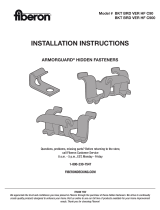 Fiberon BKT BRD VER HF C900 Installation guide
Fiberon BKT BRD VER HF C900 Installation guide
-
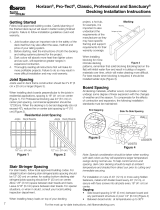 Fiberon MKT DS BRDTHG R 1FT Installation guide
Fiberon MKT DS BRDTHG R 1FT Installation guide
-
Fiberon HCRIS GRAPHITE 12 Installation guide
-
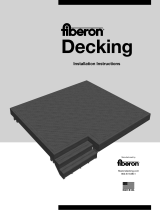 Fiberon BRDPRTFG CN 12-10PK Installation guide
Fiberon BRDPRTFG CN 12-10PK Installation guide
-
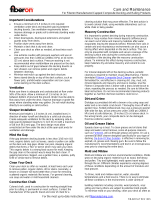 Fiberon HCFAS CT 12-10PK User guide
Fiberon HCFAS CT 12-10PK User guide
-
Fiberon HCRIS GRAPHITE 12 User manual
-
Fiberon HCFAS WESTERN CDR 12F-10PK Installation guide
-
Fiberon BRDVC FASC BW 8 User manual
-
Fiberon SEC15 M W 6KD 35.5MB Installation guide
-
FastenMaster POST SL CMP 5X45 BL User manual
Other documents
-
Severe Weather 1255878 Installation guide
-
Tapco Deck Extender User manual
-
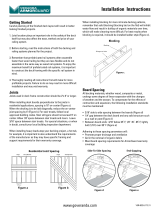 Veranda HCFAS WESTERN CDR 12-10PK Installation guide
Veranda HCFAS WESTERN CDR 12-10PK Installation guide
-
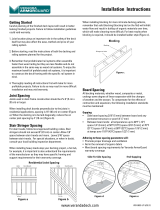 Veranda BRDVC FASC BW 8 Installation guide
Veranda BRDVC FASC BW 8 Installation guide
-
Simpson Strong-Tie EB332WDR175 Installation guide
-
Tiger Corporation JFM Stainless Steel Stackable Non-Electric Rice Warmer User manual
-
 TROPICS 265270-16 Installation guide
TROPICS 265270-16 Installation guide
-
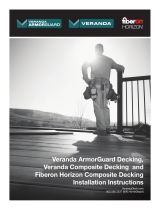 Veranda MKT DS BRDVC G 1FT Installation guide
Veranda MKT DS BRDVC G 1FT Installation guide
-
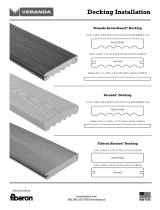 Veranda BRDVCG BW 20-10PK Installation guide
Veranda BRDVCG BW 20-10PK Installation guide
-
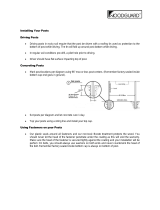 Woodguard 04-77-29085 Installation guide
Woodguard 04-77-29085 Installation guide

























